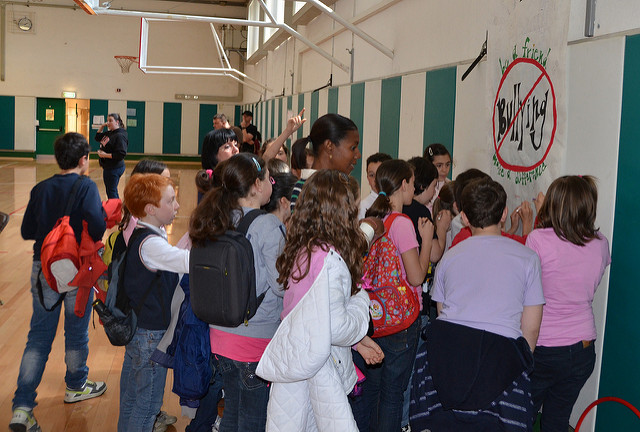Foul-weather friends: Social psychology and school aggression
 https://www.flickr.com/photos/campdarby/
https://www.flickr.com/photos/campdarby/
One classic study showed that when children intervene in bullying, it stopped within 10 seconds in 57% of episodes. This clearly speaks to the vital role bystanders play in helping victims of bullying. Nevertheless, only in 15% of the instances, children intervene. Why do some children intervene and not others? And, how can we encourage children to stand up for their peers in a helpful way?
Although, as a discipline, social psychology has studied such bystander effects for decades, it has been less than ten years since this research expertise was applied to the playground. Since then it has been shown that group processes may help us to understand children's bullying tendencies. This is the second of two blog posts that will look at school aggression from the perspective of contemporary social psychology.
In my last post, I discussed a striking observational study why peer only help infrequently, but I focused my discussion on the point of view of those who are bullying. In this post, I'll look at the perspective of the bullied victims. When it comes to the social psychology of aggression in schools, it seems that groups can both be a part of the problem and the solution, and I will discuss ways on how to attain this.
Children as Defenders
Salmivalli, Voeten, and Poskiparta (2011) showed that defending of a victim was negatively associated with the overall amount of bullying in a classroom. Sainio et al. (2011) found that being defended was positively related to a victims’ well-being, and social standing in the classroom. It's a good thing for children to defend: so who does?
One classic line of research in this area has looked at the characteristics of those who defend other children, as shown in Hawkins and colleagues' study. Salmivalli et al. (1996) developed the ‘participant-role approach’ which classifies some children into a "defender" role in the classroom. Defenders are those children who “take sides with the victims, comforting and supporting them” (Salmivalli, 2010). Children nominated as defenders by their classmates tend to be emotionally stable (Tani, Greenman, Schneider, & Fregoso, 2003) and cognitively skilled (Caravita, DiBlasio, & Salmivalli, 2009), are empathic (e.g., Caravita et al., 2009; Gini, Albiero, Benelli, & Altoe, 2007) and have a strong belief in their defending ability (Thornberg & Jungert, 2013). Defenders are well-liked (Salmivalli et al., 1996) and popular among their peers (Caravita et al., 2009). In other words, children who are defenders are highly socially skilled. Salmivalli et al (1998) also found that defending behaviour was linked to high social acceptance. So, to encourage defending, children need confidence in their social skills, and in their ability to stop the bullying by doing so.
Bullying in the Friendship Group
Children value the protection afforded by friendships, and friendships can protect children against peer victimization (Fox & Boulton, 2006). In fact, not only is the number of friends important but also the identity of children’s friends. For example, Fox and Boulton (2006) found that children with a friend scoring high on peer acceptance were less like to be bullied over time.
Friendship group ties also help children decide how to respond to bullying. When considering bullying as a group phenomenon, research has addressed the extent to which children’s involvement with a given group affects their responses to bullying. Nesdale, Durkin, Maass, and Griffiths (2005) found that children’s ethnic prejudice was positively related to strength of association with their ethnic ingroup, while Jones, Manstead, and Livingstone (2009, 2011) showed that group-based reactions to bullying intensified as a function of group membership and a sense of closeness to the friendship group. In particular, group-based anger about what was happening to the victim was associated with reporting bullying to an adult, among those who were members of the target’s group. Levels of identification with the friendship group therefore influence group members’ willingness to stick with and support the group.
Bullying in the Classroom
Thus far, I have considered the act of defending from the point of view if the individual child (what are they like as a person?) and through the lens of their friendship group (what effect does involvement in a victim's friendship group have on a tendency to defend?).
What about in the classroom context? Is there anything there which can be helpful in reducing bullying? Various proposals have been made concerning the school normative context that is optimal for reducing bullying in schools. One hypothesis is that competitive, achievement-oriented norms lead to higher levels of bullying, whereas cooperative norms reduce its incidence (see Rigby, 2007). Several studies have tested this hypothesis by establishing competitive or cooperative norms through structured play. Bay-Hinitz et al. (1994) found that prosocial behaviour increased following cooperative games, whereas aggressive behaviour decreased; the reverse pattern emerged after competitive games (see also Garaigordobil et al. 1996). In my own research, I have found that children who play a cooperative game then expressed less pride and more regret and anger about a fictional bullying incident than those who played a competitive game. Thus, a cooperative ethos in the classroom might help to reduce children's tendencies towards bullying.
Conclusions
As much as my previous post offered an explanation as to how social psychology can help us to understand the problem of bullying, this post indicates that social psychology may also form part of the solution. Individual characteristics of children who defend are just a part of the story. Other motivations to aid victims might come of children's friendship group associations, and of the ethos in their classroom. Encouraging children to reflect on their responsibilities towards their friends if they are caught up as victims of bullying, and promoting cooperative activities in the classroom might go some way to reducing the incidence of peer victimization in schools.
References:
Atlas, R. S., & Pepler, D. J. (1998). Observations of bullying in the classroom. Journal of Educational Research, 92, 86–89.
Caravita, S., Di Blasio, P., & Salmivalli, C. (2009). Unique and interactive effects of empathy and social status on involvement in bullying. Social Development, 18, 140–163.
Fox, C. L., & Boulton, M. J. (2006). Friendship as a moderator of the relationship between social skills problems and peer victimisation. Aggressive Behavior, 32, 110-121.
Gini, G., Albiero, P., Benelli, B., & Altoe, G. (2007). Does empathy predict adolescents' bullying and defending behavior? Aggressive Behavior, 33, 467–476.
Hawkins, L., Pepler, D. J., & Craig, W. M. (2001). Naturalistic observations of peer interventions in bullying. Social Development, 10, 512-527.
Jones, S. E., Manstead, A. S. R., & Livingstone, A. G. (2011). Ganging up or sticking together? Group processes and children’s responses to bullying. British Journal of Psychology, 102, 71-96.
Jones, S. E., Manstead, A. S. R., & Livingstone, A. G. (2009). Birds of a feather bully together: Group processes and children’s responses to bullying. British Journal of Developmental Psychology, 27, 853-876.
Kendrick, K., Jutengren, G., & Stattin, H. (2012). The protective role of supportive friends against bullying perpetration and victimization. Journal of Adolescence, 35, 1069-1080.
Nesdale, D., Durkin, K., Maass, A., & Griffiths, J. (2005). Threat, group identification, and children’s ethnic prejudice. Social Development, 14, 189–205.
Rigby, K. (2005). Why do some children bully at school? The contributions of negative attitudes towards victims and the perceived expectations of friends, parents and teachers. School Psychology International, 26, 147-161.
Sainio, M., Veenstra, R., Huitsing, G., & Salmivalli, C. (2011). Victims and their defenders: A dyadic approach. International Journal for Behavioral Development, 35, 144-151.
Salmivalli, C. (2010). Bullying and the peer group: A review. Aggression and Violent Behavior, 15, 112–120.
Salmivalli, C., Lagerspetz, K., Bjorkqvist, K., Osterman, K., & Kaukiainen, A. (1996). Bullying as a group process: Participant roles and their relations to social status within the group. Aggressive Behavior, 22, 1-15.
Salmavalli C., Voeten M., & Poskiparta E. (2011). Bystanders matter : associations between reinforcing, defending, and the frequency of bullying behaviour in classrooms. Journal of Clinical Child and Adolescent Psychology, 40, 668-676.
Tani, F., Greenman, P. S., Schneider, B. H., & Fregoso, M. (2003). Bullying and the Big Five: A study of childhood personality and participant roles in bullying incidents. School Psychology International, 24, 131-146.
Thornberg, R., & Jungert, T. (2013). Bystander behavior in bullying situations: Basic moral sensitivity, moral disengagement and defender self-efficacy. Journal of Adolescence, 36, 475-483.
Woods, S., Done, J., & Kalsi, H. (2009). Peer victimisation and internalising difficulties: The moderating role of friendship quality. Journal of Adolescence, 32, 293-308.

